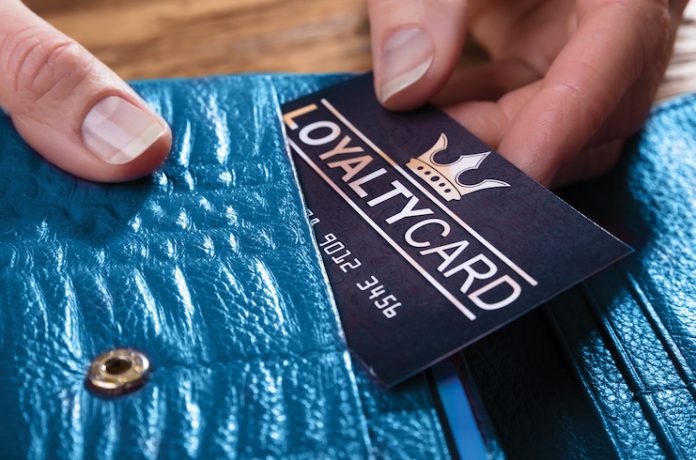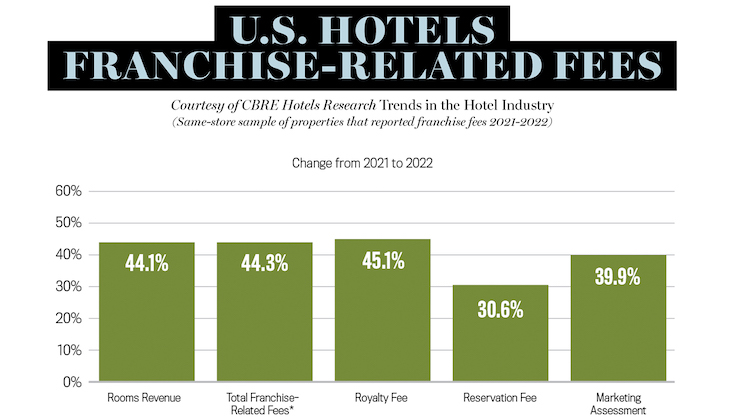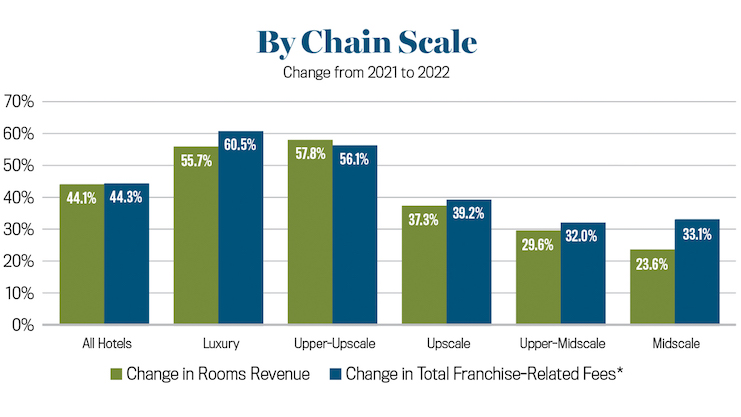
Over the years, the fees hotel owners pay to franchise companies have typically grown at a pace greater than the rise in hotel rooms revenue. Most franchise-related fees are charged as a percent of rooms revenue, and therefore, by assessing the relative changes in rooms revenue and franchise fees we can make some assumptions.
In 2021, acknowledging the financial stress hotel owners faced during the pandemic, the franchise companies were sympathetic and provided some reprieve. While rooms revenue increased by 55.4 percent in 2021, total franchise-related fees rose by just 45.9 percent. Equilibrium returned in 2022. During that year, rooms revenue grew by 44.1 percent, while total franchise-related fees increased by 44.3 percent.
One component of the total franchise-related fees paid by hotel owners to their franchise organizations are guest loyalty program fees. Per the 11th edition of the Uniform System of Accounts for the Lodging Industry, loyalty program fees include “any costs associated with programs designed to build guest loyalty to the property or brand.” In 2022, the fees to cover the costs of guest loyalty programs increased by 53.8 percent—9.5 percentage points greater than the growth in rooms revenue during the year. In fact, guest loyalty program fees have consistently increased at a greater pace than rooms revenue since 2007. Because of the growth in guest loyalty program membership and positive impacts on performance, owners don’t necessarily mind paying the extra cost. To gain a better understanding of recent trends in franchise fees and guest loyalty program costs, CBRE analyzed the franchise-related payments made by 3,421 U.S. hotels from 2021 to 2022. In 2022, these hotels averaged 176 rooms and achieved a 67.5 percent occupancy with a $176.35 ADR. For our Trends in the Hotel Industry survey, CBRE captures four different franchise-related fees on a discrete basis:
- Royalty fees
- Marketing assessments
- Reservation fees
- Guest loyalty program fees
For this analysis, the sum of these four components comprises “total franchise-related fees.”
From 2021 to 2022, royalty fees (45.1 percent growth) was the only other component of total franchise-related fees that increased at a greater pace than rooms revenue. Reservation fees (30.8 percent) and marketing assessments (39.9 percent) each grew at a pace slower than rooms revenue.
Differences by Management and Chain Scale
From 2021 to 2022, we noticed a slight disparity in the change of franchise-related fees made by hotels that were operated by a brand, versus those operated by a third-party management company. When negotiating management opportunities, the brands have some flexibility in the fees charged since they are receiving payments for both the franchise affiliation and management of the hotel. Therefore, it is not surprising that franchise-related fees (55.3 percent growth) increased slightly less than rooms revenue (56.4 percent) at the brand-managed hotels. On the other hand, franchise-related fees (41.6 percent) grew a little more than rooms revenue (38.8 percent) during 2022 at the third-party managed properties.
Greater disparities between the growth of rooms revenue and franchise fees from 2021 to 2022 were observed by chain scale. The total franchise-related fees grew greater than rooms revenue at luxury, upscale, upper-midscale, and midscale hotels. Upper-upscale and economy properties saw their rooms revenue increase at a greater pace than total franchise-related fees during 2022.
Guest Loyalty Program Fees
Guest loyalty program fees have consistently increased at a greater pace than total franchise-related fees over the past 16 years. This implies that the loyalty program members are a growing source of paid revenue.
There appears to be a linear relationship between chain scale and guest loyalty program fee payments. In general, guest loyalty program fees make up a greater share of total franchise-related fees at the higher-priced chain scales. In 2022, guest loyalty program fees accounted for over 25 percent of total franchise-related fees at luxury and upper-upscale hotels. These hotels accommodate a high degree of corporate and convention travelers, a profile of guests that constitutes a significant share of hotel loyalty program membership. On the other end of the spectrum, guest loyalty program fees are just 2.4 percent of total franchise-related fees at economy hotels, implying that fewer loyalty program members stay at economy hotels.
As expected because of the higher room rates, guest loyalty program fees are also the greatest when measured on a dollar-per-available room (PAR) basis at luxury ($1,288 PAR) and upper-upscale properties ($1,217 PAR). At economy hotels, this charge averages just $40 PAR.
Loyalty Program Benefits (For Hotel Owners)
As guest loyalty program fees rise, owners want to know what they are receiving in return for cost increases. Guest loyalty programs help branded hotels lower their customer acquisition costs, increase direct-to-customer engagement, and offset any occupancy shortfalls during economic downturns and off-peak periods.
Major hotel brands have been actively expanding their loyalty membership base through traditional methods as well as through a proliferation of credit card programs and other strategic alliances. A closer look at the aggregate loyalty metrics of the five major U.S. hotel brands reveals that in 2022, loyalty members redeemed a record number of points that were earned and saved during the pandemic. Furthermore, over the past 10 years, the growth in loyalty members has outpaced the growth in total room supply. The growth in the average number of loyalty members and the number of members per room since 2019—up 35 percent and 22 percent, respectively — means that the major brands now have the largest database of potential guests in their history. This should continue to reduce customer acquisition costs and help provide “occupancy insurance” should the economy falter.
For the five major brands, the total value of loyalty point redemptions and “other” revenues increased 36 percent to $982 million since 2019. The increase in revenue associated with point redemption, along with a steady loyalty contribution to occupancy, could reflect the variable number of points needed to reserve a room coupled with the record-high ADRs. Alternatively, it could indicate that points are being redeemed for more expensive properties and prime destinations, consistent with the higher guest loyalty program fee PAR at upper-price tier properties.















One component missing in this article is that of mandatory enrollments to “lower the loyalty program fees”. Although we see cited many times that Reward Program members make up a larger portion of our guests, it is because of the mandates and the fact that the facilitators of our program re-activate inactive accounts which hold inaccurate information. In addition, several of our Rewards members have several accounts which allows the Franchisor to claim vast numbers when, in reality, you would have to take off at least 20% as being actual.